The three forest pests
26% of the surface of our planet is covered with forests. This is a total of 3.5 billion hectares of boreal forest (which occupies part of Canada and the US). and part of the USSR and represents a quarter of the total forest area) and tropical, humid or dry forests (the most extensive and wonderful and constitutes half of the world forest heritage).
The resources distributed around the world are: 17 countries occupy 75% of the forest area, leading the USSR 20% of the area. It is followed by Brazil (around 14%) and Canada (around 7%). France, for example, with 14 million hectares, has less than 0.5% of its area. However, a quarter of its surface is occupied by forests and is the largest area in Europe. It is also very rich in tree species, with a total of 89 species. 90% of Finnish forests, for example, are made up of only three species. However, it is far from the potential of tropical forests, where more than half of the planet's tree and animal species are found.
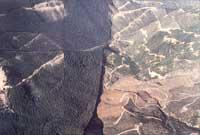
However, global forest wealth is in danger and the first cause is tropical deforestation. While the boreal forest remains stable and the temperate forest increases slightly, the latest figures indicate that the 1.6 billion hectares, which in principle were double that cover the tropical forests, are falling 1% per average year. Along with this, 5,000 species of living are disappearing every year.
Deforestation
A satellite photo attracted attention in 1988: The amazing forest of the Amazon was covered with clouds of opaque smoke. This was a consequence of many small fires. The largest humid forest in the world, the immense genetic reserve, resource wells and the mythical “virgin” sanctuary still untapped, are disappearing faster than predicted by statistics.
In 1990, the World Resources Institute (WRI) report put Brazil at the head of deforesting countries, which in the Amazon are disappearing between four and eight million hectares each year. But Brazil is not the only one that enjoys current news in this chronicle of lost hectares. In 1981, the Food and Agriculture Organization of the United Nations estimated that the surface of the world's tropical forests was 1.8 billion hectares (47% in South and Central America, 36% in Africa, 17% in South and Southeast Asia and the Pacific islands), of which 60% are compact humid forests (annual rainfall exceeding 1,500 mm) and 40% savannah forests.
This forest in 1981 had receded 11.3 million hectares (a fifth of France). In 1990 this decline increased markedly: In the period 1981-1991 the average annual area is 17 million hectares. This means that annual deforestation is currently 20 million hectares. Some believe that for a century tropical forests can disappear completely.
This deforestation is worrying, although the roughness of numbers conceals some details. There is no reliable estimate at all. It is not clear what is called “forest”. Should we introduce wooded savannah and tree lines? or just take dense forests?
Contrary to what is sometimes believed, the progressive disaster of tropical forests is not mainly due to the exploitation of tropical wood, but to inadequate agriculture and the collection of firewood. Of the 536,000 hectares lost annually in the Zaire forest, 350,000 have been occupied by indigenous farmers, 180,000 are used as fuel and 6,000 correspond to what was spent on forestry.
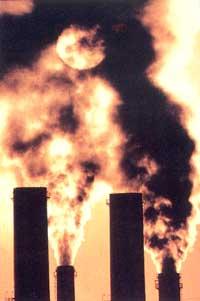
The lack of land for agriculture has led farmers to occupy the last lands of forests. The fires that cloud the atmosphere of the Amazon, many small farmers are remnants of the fireworks. In humid forests they occupy small areas (rarely more than one hectare) where they sow corn, manioc or beans. Two or three years later, the organic matter of these fragile lands will be mineralized.
To cope with fertility loss, farmers will advance something else. However, this system of itinerant growth has maintained a balance. In the rear fallow, the vegetation, with enormous dynamism, has grown very fast. Thirty years later the peasants returned to these lands and the forest and humus were almost rebuilt.
But the pressure for population growth has worsened. The phenomenon is very important in the continental forests of the Southeast Asian coast. Along the Gulf of Abian there is population growth above 3% and no more forests. In Bolikosta the tropical forest has gone from 15 million hectares to 3.5 million hectares in a few decades, which have been used for planting cocoa and coffee. The Amazon, due to the speed of the process, has taken the form of crisis.
With the construction of roads for forestry and mining or for the military, the poor population of the Northeast (and then that of the South) has led them to seek lands that are denied due to the lack of agrarian reforms. Nearby and easy farmland has decreased considerably and the forest does not rest. The soil is not allowed to regain its fertility. The crop has been completely abandoned and is sometimes used for extensive livestock. The retreat of the tropical forest is almost irreversible.
Wood harvesting is the main threat to dry tropical forests. Here the pressure of the population is very high. Wood is the only energy source for almost half of the world's population and is missing more than 300 million inhabitants. About 800 million people, most of them around large cities, exploit the resources needed to meet their needs. Niamei or Bamako, for example, are supplied in wood at 100 km.
Logging barely affects deforestation (about half a million hectares a year), except in Southeast Asia, where it is often very intensive and devastating. While in Africa and America the prized species are very dispersed, in Asia there are areas very rich in commercial woods that extract 80 cubic meters of wood per hectare, four times more than in Africa. Once the machines have passed, the land is destroyed.
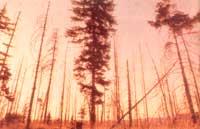
All admit that the disappearance of tropical forests is very serious. Today its richness in sun, water and minerals and its biological abundance are known. More than half of the living species live here. In Guyana, about three hundred tree species have been detected on a plot of one hectare. Therefore, using the argument of being a heritage of society, people are calling for full protection of tropical forests.
However, there are other opinions. The dream is to turn these forests into sanctuaries. This vision is not acceptable to residents. In the West we exploit our forests. Why should the South not use their resources? In Indonesia, forestry accounts for 29% of exports (excluding oil) and 3.4 million people work there.
Today it seems that the progress of deforestation is unstoppable and, although it cannot be prevented, controls must be made. For example, there are those who believe that the environment is the adequate supply of forests, forest harvesting and the mixture of stable agriculture. This requires improving agricultural techniques and taking advantage of the new vision of forest exploitation. The solution is not to throw precious trees on demand. Nor the implementation of large artificial plantations to obtain wood for construction, some of them with great success.
The production of species of interest in the tropical forest must begin. But they will be useless techniques, if there is no willingness to apply them, and especially if no adherence to general interests is demonstrated. The new generation projects being carried out in Africa are based on the involvement of its inhabitants and the consideration of their needs.
Despite harvesting needs, it is not possible to give up the comprehensive conservation of some areas of tropical forests. But what surface will be used to ensure the conservation of biological abundance? and where? It is not yet clear on what criteria these comprehensive reserves will be created. We still know little about the complex mechanisms that govern these ecosystems and it can be quite late to start adapting.
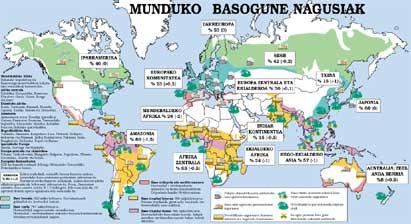
Forest conditions
European forests are about to die. News of damage to temperate forests has been spreading in the form of rumors. The creation is located: In West Germany in the early 1980s. It immediately spread to all of Europe and then to North America. The news spread was very noisy and surrounded by important studies.
No one has dreamed. For some years the rabbits of the Black Forest and surrounding areas have lost their brambles. They were initially blamed for air pollution caused by industries. Subsequently a very prominent case has been used in the Metal Mountains of Czechoslovakia. In these mountains the sulfur powders and fumes of the surrounding industries have been dispersed for years, completely disappearing all vegetation. In this case, total tree poisoning stands out. The situation in Germany or France, however, has nothing to do with this extreme situation in which the forest is disappearing (perhaps less so in China).
The conclusions of the first studies on the relationship between air pollution and forest diseases have not found a direct relationship between both phenomena. It is true that industrial and agricultural activities are not innocent. However, it seems that the main factors that prevent the life of trees must be found in climatic factors and in failures in the forest industry.
Forest diseases have lost leaves to some resinous species that are the largest forest population in central Europe (two-thirds of Germany). In 1980 he appeared in the Sudetenland of Vosgeas. Signs similar to those observed were detected in the United States, while Canadians were concerned about weakening their maples. Five years later in Europe the second phenomenon was discovered: trees, especially fir trees, began to love their leaves. When it seemed that the resinous had overcome the crisis there appeared indications that the leafy species were losing vitality.
The emergence of numerous forest catastrophes has cast doubt on the tendency to attribute the impact to a single polluting factor. They have been proposed as sulfur dioxide agents, nitrogen oxides or ozone, but never with much foundation. In the United States and France, investigations into the mountain disaster are not polarized to air pollution, there are suspicions of a group of causes, including climate factors.
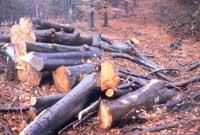
A study on the behavior of the fir forests of the Vosge mountains in France over the last hundred and fifty years has offered proof. Analyzing the size of the tree rings, he showed that their dynamism is closely related to the climatic conditions of that summer, but also to those of the previous six years. The great drought of 1976, for example, had its consequences in 1982, when the pests lost their needles more. Leaf loss is one of the strategies of trees to combat water stress. The resinous, ancient pioneer species, have colonized the limits of their natural climate and geological habitat. They are very sensitive to the changes that affect them.
Under these conditions, proper forestry can be decisive. For example, if the Vosge firs had been cleared before, the 1976 drought would not have had so much influence; competition with water could not be so fundamental. In this particular case it does not seem that air pollution has had a significant incidence. The emission of nitrogen compounds can also explain the marked trend of increased productivity observed in the mountains. On the other hand, the loss of leaves of the resinous has receded. The European Community's annual report on forest health notes: In 1989, 9.9% of the trees under average study were damaged, 10.2% in 1988 and 14.3% in 1987.
On the other hand, there is the problem of yellowish leaves, which in 1989 reached 16% and slightly more than 13% in the previous two years. It has been a surprising phenomenon, which has occurred for ten years and has concerned forestry experts. This condition appears to be caused by air pollution and in particular by acid rain. These precipitations are due to the molecules of sulfur dioxide and nitrogen oxides emitted by fossil fuels and car circulation, increasing the wounds of the leaves and causing the lack of mineral salts (calcium, magnesium, etc. ).
But it is the land that influences the most. The drainage produced by acid rain in the Vosge mountains has measured that it impoverishes the annual substrate in magnesium by 1%, which is much. In most of the mountains mentioned, a soil no longer rich in minerals is threatened. There is a great risk of seeing yellowish trees in the coming years. The Germans are ahead. To reverse the phenomenon, a soil fertilization plan (1,000 hectares per year) with lime has been implemented.
In the United States, increasing acceptance is being imposed in Europe: air pollution is involved but not the only cause of these damage. It is concluded that in about fifteen species of highly studied American resins (California, East and Appalachia) the loss of life may be due to ozone contamination.
Ten years after the alarm, it has finally been considered that these forest diseases have a solution and have only ended with a few trees. The total disaster has not occurred. But concern for the environment has served at least to advance anti-pollution regulations and to conduct in-depth studies on the incidence of pollution. The dossier, however, is not closed: this damage located in temperate areas begins to appear in New Zealand, Hawaii, Alaska and Pacific Islands, where there is hardly any air pollution.
Fires

For about ten years, the forest fire has a great relevance every summer. In France an average of 35,000 hectares of forests are calcined, mainly on the Mediterranean coast. A terrible fire turned Québec's surface to ashes almost ten times in the last month of June. Logs were smoking for almost six weeks. Over more than fifty years it has not been known, as the area destroyed in 1941 amounted to 642,455 hectares.
Wildfires are inevitable. Whether large or small, they resist opposing systems and their economic, ecological or social effects can be tremendous. In the American states of Oregon and Washington, lightning is the main cause of fire. Natural fires, with a dozen or more years, attack forests and help them adapt.
Only from the ecological point of view, the environment is not threatened by the mere pass of fire. Despite being a fire that passes to all vegetation attacking or narrating through the ground, the vegetation grows again on its own. If storms do not completely erode the soil or if another fire does not light up too quickly, competition between species arises again.
Moreover, some specimens of resinous species get sick in the pineapples and are so hard that they can only get rid of the heat of the fire. As a vector of natural selection and biodiversity, fire contributes to the creation of a new forest that, years later, will become mature forest. The famous Yellowston Park fire, which burned 635,000 hectares in the northwest of the United States in 1988, was abandoned to be extinguished on its own in the name of the eco-friendly “laisser–faire”.
We must recognize, however, that natural bonfires are very scarce. In Australia, 90% of fires are man-made. In France only 30% to 6% of the fires detected came from lightning. 11% have malicious origin and this questions the idea that they are the main Pirous responsible for the “red summers”. Most (about 70%) are due to negligence or accident. The terrible fires have never entered this last category.
Between 1982 and 1983 the eastern humid tropical forest of Calimantán de Borneo was destroyed in about 11 months. The small farmers before planting burned their plots to clean them. They believed that the rainy season was going to extinguish those fires, but it didn’t rain… and the fire didn’t go out until the following year. Balance: 3.5 million hectares have disappeared from the forest map for a few years.
The influence of fires is not always measured by balancing the destroyed surface. In the Mediterranean area, for example, the damage is social. Nobody cares about the cubic meter of roasted pines. The forest has lost its economic function becoming a leisure environment that needs security. Unlike rural pine forests, the Mediterranean forest has not been preserved at all. Branches, bushes and dried herbs have been stacked and become the first food to cause a fire. North Africa does not have this problem, as animal groups traverse forests and feed on ponds.
Much progress has been made in the prevention of fires, but it has given rise to a great paradox: when the small fires (which are faced in time) disappear, the fuel is complete in form and in breeze, increasing the risk of a catastrophic fire that frightens everyone every year. The solution is clear: clears the mountain. Chemical phytocells, sheep and goats or very controlled fires can be used to remove these bushes. But there are species that do not support this last treatment very well. For example, tourists, black forests chase them away.
Buletina
Bidali zure helbide elektronikoa eta jaso asteroko buletina zure sarrera-ontzian











